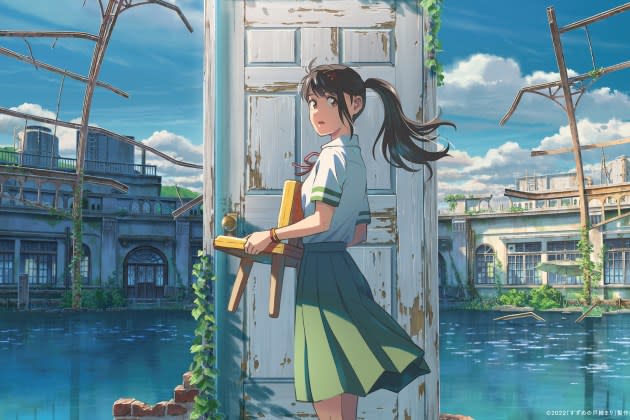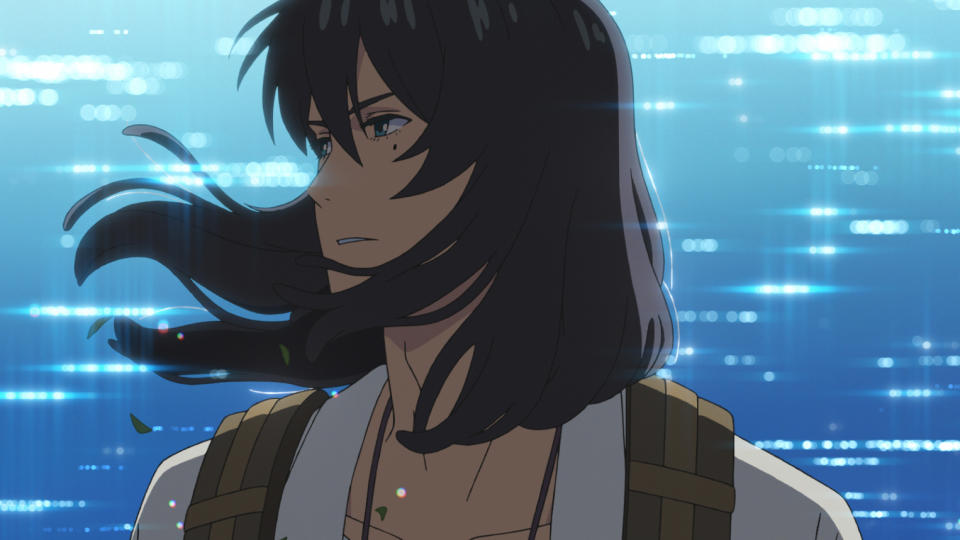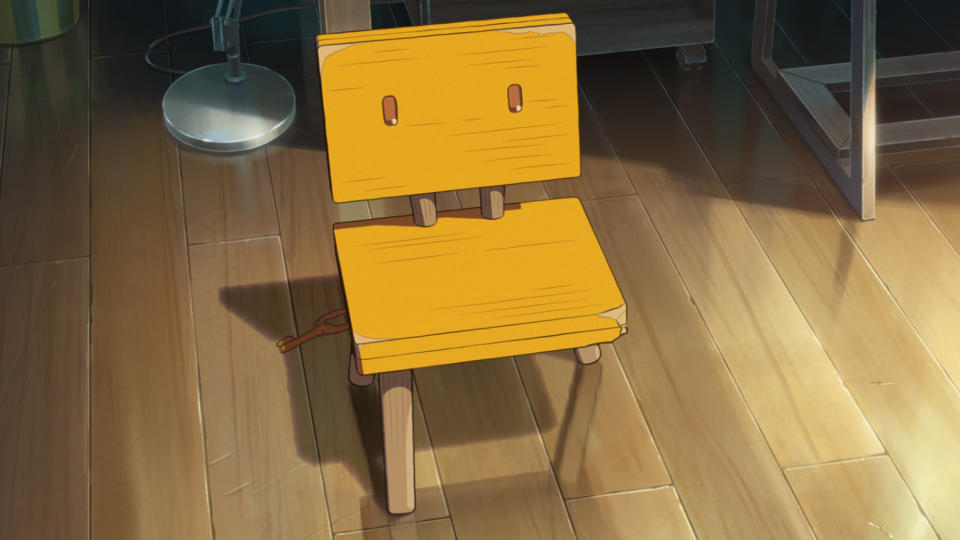Director Makoto Shinkai On The Tender Resonance And Maturity Of Making ‘Suzume’: “I Think About How To Dig Deeper So I Can Emotionally Move People In My Vicinity”
- Oops!Something went wrong.Please try again later.
- Oops!Something went wrong.Please try again later.
- Oops!Something went wrong.Please try again later.

SPOILER ALERT: This interview includes details about Crunchyroll’s Suzume.
Writer-director Makoto Shinkai continues to reap the rewards of building his ecological cinematic universe. Following the recent success of his domestic, international, and record-breaking hits Your Name and Weathering With You comes his latest light romance adventure film Suzume. The film follows a 17-year-old girl named Suzume (Nanoka Hara)who joins forces with a young man named Sōta (Hokuto Matsumura) to track down and close a series of mysterious and supernatural portals that have the potential, once opened, to release devastating natural disasters all over Japan. Since its release in Japan last year, Suzume has earned the designation of becoming the fourth-highest-grossing film of all time in Japan and globally; it also garnered especially attention at the Berlin Film Festival earlier this year, as it was the first Japanese animated film to play in competition in two decades. With such accolades acquired mere months before its wider international release in theaters on April 14, it’s clear that Suzume should not be ignored.
More from Deadline
'Superstore's Nichole Sakura To Lead English-Language Voice Cast Of Crunchyroll's 'Suzume'
'Minari' Director Lee Isaac Chung Parts Ways With Paramount And Bad Robot's 'Your Name' Adaptation
Here, Shinkai sits down with Deadline to thoroughly discuss his continued efforts in paying respects to the Great East Japan Earthquake, the beauty of animation, and exploring themes of grief, trauma, and romance to capture the emotional tenor of Suzume.
DEADLINE: Most of your filmography centers around Japan’s proclivity to natural disasters, namely, the 2011 Tōhoku earthquake. But more so, in Suzume, you explore the aftermath of the devastation by hinging the plot around the usage of abandoned locations. Can you tell me more about the symbolism behind showcasing these destinations and your resonance with them?
MAKOTO SHINKAI: With Suzume, the different towns she travels to are all disaster-stricken areas. And I would say even some Japanese audience members may not recognize them, especially the worldwide international audience, I would say, especially so. But for me, that’s OK. I feel that certain ruins that you see in the backdrop of the film are almost these wounds of the country that Suzume travels through and goes through each one and heals them in some way.
So once Suzume departs Kyushu, she first arrives in Ehime, where in 2018, due to massive rainstorms, there were landslides that rendered a bunch of areas unlivable. And then she goes to Kobe, where in 1995, there was a massive earthquake. And then Tokyo, where in 1923, a hundred years ago, again, another massive earthquake. Finally, passing through Fukushima, where there was a huge meltdown of the nuclear power plant as a result of the 2011 earthquake and tsunami, rendering that entire area quarantined. So, these certain wounds, I feel, the ruins in each area represent a wound of the country that cuts quite deep. But while Suzume can travel through each of them and close these doors, bringing that level of closure in some way, she’s also bringing some level of closure to herself, which I think contributes to her growth and worldview shifting towards more of the future.
DEADLINE: You also use the form of a giant worm to reflect this catastrophic impact on Japan’s land; what went into that?
SHINKAI: Japan is a very earthquake-prone region in the world. So ancient Japanese people imagined there must have been some kind of gigantic creature that dwelled beneath the islands of Japan.And depending on the era, it took the shape of a long, skinny dragon or a giant catfish that stretched amongst the isle of Japan. And in this instance, for Suzume, I believe the earthworm represents the earth itself; it eats dirt and spits out dirt, almost like the existence of land itself. And the worm moves similarly to an earthquake; it doesn’t act with any logic, rhyme, or reason. One thing I was careful about, though, was making sure it didn’t appear too monster-like; I didn’t want it to look like Godzilla [laughs].
DEADLINE: Your prior films have broken many box office records in Japan and are critically acclaimed globally. Suzume was the first Japanese animated film shown in 20 years at the Berlin Film Festival. What do you think audiences are responding to in your movies, especially that of Suzume?
SHINKAI: With my films, personally, I don’t really think about the global markets early on in development. I try hard to depict something very local and intimate to me, depicting where I live and what I know, and I think about that as almost the ground I’m standing on. I try to think about that and how to dig a little deeper and how to understand [my own connections] so I can try to emotionally move the people in my vicinity, which is a more domestic Japanese audience. But as I think about that metaphor, the deeper I dig, perhaps you can end up on the other side of the world and, in doing so, move audiences in a different way and have something universal that resonates with them.
So again, I don’t go out trying to make this, “Oh, I’ve got to put these elements in; therefore, it’s global and international and will resonate.” I just focus on the local, dig deeper and deeper, and end up with something that I think perhaps speaks to people. But personally, I’m not really sure myself why the audience reacts to my films [laughs].

DEADLINE: Aside from the screenplay, the incredible vocal performances carry a lot of the film’s weight. Nanoka Hara and Hokuto Matsumura, as Suzume and Sōta, respectively, sound just as fierce and tender as their characters onscreen. What about them stood out to you in the audition process to cast them?
SHINKAI: The decision and reason to cast both of them are quite similar, and that’s because of this sort of doubt they had during the audition process. So, for both Nanoka and Hokuto, I auditioned, especially specifically Nanoka, out of over 1,700 auditions, and it came from actresses, voice actresses, singers and people in various practices and disciplines. And we had a range of plus/minus a few years from 18, which was Suzume’s age.
Ultimately, I found this strange doubt and anxiety attractive in both of them because it was their first time doing voice acting. They both have an acting career and are familiar with acting, but not voice acting for a film like this. So, their auditions were both energized yet had a little bit of that doubt and anxiety and that combination, I thought, was perfect for their characters. Because in a similar way, Suzume sets off on this journey, yet she’s missing a piece of her heart or her mind because of the trauma she experienced as a young girl. So that doubt, as she overcomes it in the recording booth, I thought would also translate to the character’s growth and then, ultimately, to the audience. They can see her character grow and evolve throughout the film like the voice actors were evolving in the recording booth.
And we recorded this film, the voice acting, last summer for two months straight. I was in the recording booth with both of them, going through each scene by scene. It almost felt like a summer camp, and I was the teacher in some kind of way, educating and guiding these two young souls through the recording over the summer. And really, I was able to witness their growth, which I think translates to the character’s growth as well.
DEADLINE: There are many themes in this film, but one of the themes that I picked up on the most was, perhaps, freedom. Suzume needs to be free from her trauma, Sōta needs to be freed from his family’s self-sacrificing traditions and Aunt Tamaki from the stigma of having to take care of her niece at a young age unexpectedly. Which was the most challenging storyline or theme to get across for your film? And how did you overcome that challenge?
SHINKAI: Suzume’s character arc and development is one of the biggest themes, the tree trunk, if you will, of this entire story. Getting her to a point where she’s able to say, “I’m off,” and open the door, I put most of my effort in there. But I would say one of the other big challenges and personal interests of mine was Tamaki’s character. The relationship and dynamic between Suzume and Tamaki is one that I haven’t really explored before.
There’s a scene where Tamaki just shouts out, “Give me back my life!” And I would argue that all parents, to some degree, probably felt that, on some level, to their own kids. For me personally, I was very focused on work, but that doesn’t mean that certain sacrifices were made to a degree. Obviously, it’s something, socially, in Japan, and I’m sure around the world, you can’t say that to a young kid and push that burden onto them. But at some level, that choice means certain sacrifices will come with it. But the fact that I was able to have Tamaki shout that and scream that, perhaps on behalf of the parents for me, made me really happy. But I know it’s something that was a challenge as well.

DEADLINE: Daijin is a challenging character to understand at times. He’s so mischievous and a little mean. But we’re supposed to feel bad for him, right? Because he wants to be free and live a normal life as a cat. In developing his character, where do you want audiences to land? What do you want audiences to think about?
SHINKAI: With Daijin, in terms of the sort of story building and plot progression, plays the role of trickster, if you will, which is a character that appears out of nowhere and ruffles things up, and everyone’s left with a situation that they have to solve and overcome. But at the same time, he’s this trickster character. He also metaphorically represents nature because Suzume is facing, is nature itself. And to me, nature can be quite whimsical.
Take the ocean, for example. One moment, you can look at it. It’s this beautiful body of water. But the next, it could turn into a tsunami and attack you. So, it’s this unpredictability and lack of control you can exert over nature that I wanted to represent in an animal. And thinking about what whimsical, unpredictable, uncontrollable animal you have, the cat, of course, is the one that came to mind. But perhaps I made him a little too cute because I think a lot of audiences felt bad for the cat. Daijin never really has his own resolution or cathartic moment. But by that same token, I, personally saw Daijin as a god or something divine elevated from our human plane. So, in some ways, it was his role or his responsibility to fulfill that role of the keystone.
DEADLINE: Speaking of making someone too cute, a lot of the discourse online, and even on your Twitter feed, involves turning the handsome lead, Sōta, into Suzume’s childhood chair for more than half the movie, which is so funny and risky. What was the most difficult and fun aspect for you in working with the animation team for his transformation?
SHINKAI: One of the funniest challenges of design definitely comes from the chair. I didn’t want to make Suzume having a partner [be the sole focus of the movie]. I wanted to steer away from that romance, the sexual tension, the “will they, won’t they” type of tension that I’ve done in my past films. Part of that is because, at the foundation, this film is about the 2011 Great East Japan Earthquake. Having depicted that in a very straightforward fashion, the movie would’ve been very serious and very heavy. So, whoever is standing opposite of Suzume, I wanted them to offer a comic relief type of role, which is why, ultimately, we replaced Sōta as a chair and put him next to her. Trying to imagine Suzume and a handsome guy road-tripping and traveling through Japan alone… it would have been a very different movie, I think, tonally [laughs]. So, adjusting that mood was a large reason why we settled on a chair for Sōta’s character.
With regards to animating the chair, there were definitely its own set of challenges. Initially, after designing the chair, we attempted to animate it using 2D hand-drawn techniques. We had a few samples, but it felt very much alive in a way that I didn’t want Sōta to be, reminiscent of Disney’s Beauty and the Beast, where a lot of the fine china are dancing. But ultimately, we settled on using 3D CGI because the object itself was very solid, and I wanted it to feel like he was trapped in something, almost cramped into this rigid, stiff object and texture, and give it that awkward feeling. Animating the chair, again, came up with its own set of challenges, but ultimately, we settled on that to depict and express that feeling of being trapped.
And ultimately, I’m really glad that we settled on a chair because I’ve had the opportunity to tour many different cities around the world with this film, and when I show up on stage for a Q and A session, I’ll be holding [a replica] Sōta. And that alone gets this huge reaction out of the audience, and there’s cheer and clamor around that. So, chair Sōta is playing a massive role within the film, but also is helping the film outside in our reality and timeline as well.

DEADLINE: You end the movie in a thought-provoking and powerful way in which Suzume must console her younger self through the grief that she’s facing in order to move forward to her present self. How did you land on that idea?
SHINKAI: The movie might seem fantastical, but I believe that talking to a past version of ourselves is something that we actually do every day. For example, maybe something bad happened to you in grade school, and now as an adult, you can recall that event saying, “You know what? I’m sure it was tough back then, but things will get better as you grow up.” This is something I do when I recall certain memories.
For example, maybe something really bad happened to you in grade school, and you can imagine yourself as an adult now imagining, recalling that event saying, “You know what? I’m sure it was tough back then, but things will get better as you grow up.” This is something that I do when I recall certain memories. So, I believe that in the present, we are constantly talking to our past selves through memories and trying to cheer our future selves on through very difficult situations that come at us in life. So, I thought for Suzume that depicting that scene was a means to help propel her and ourselves through difficulty.
So, I believe us in the present, we are constantly talking to our past selves through memories and our future selves by trying to cheer ourselves on, getting us through very difficult situations that may come at us in life.
You can catch Suzume now playing in theaters.
[This interview, conducted through an interpreter, has been edited for length and clarity]
Best of Deadline
2023 Awards Season Calendar - Dates For Emmys, Major Film Festivals & More
Fox Fall Premiere Dates: 'Masked Singer', '9-1-1', Animation Domination, Three New Series & More
Sign up for Deadline's Newsletter. For the latest news, follow us on Facebook, Twitter, and Instagram.

